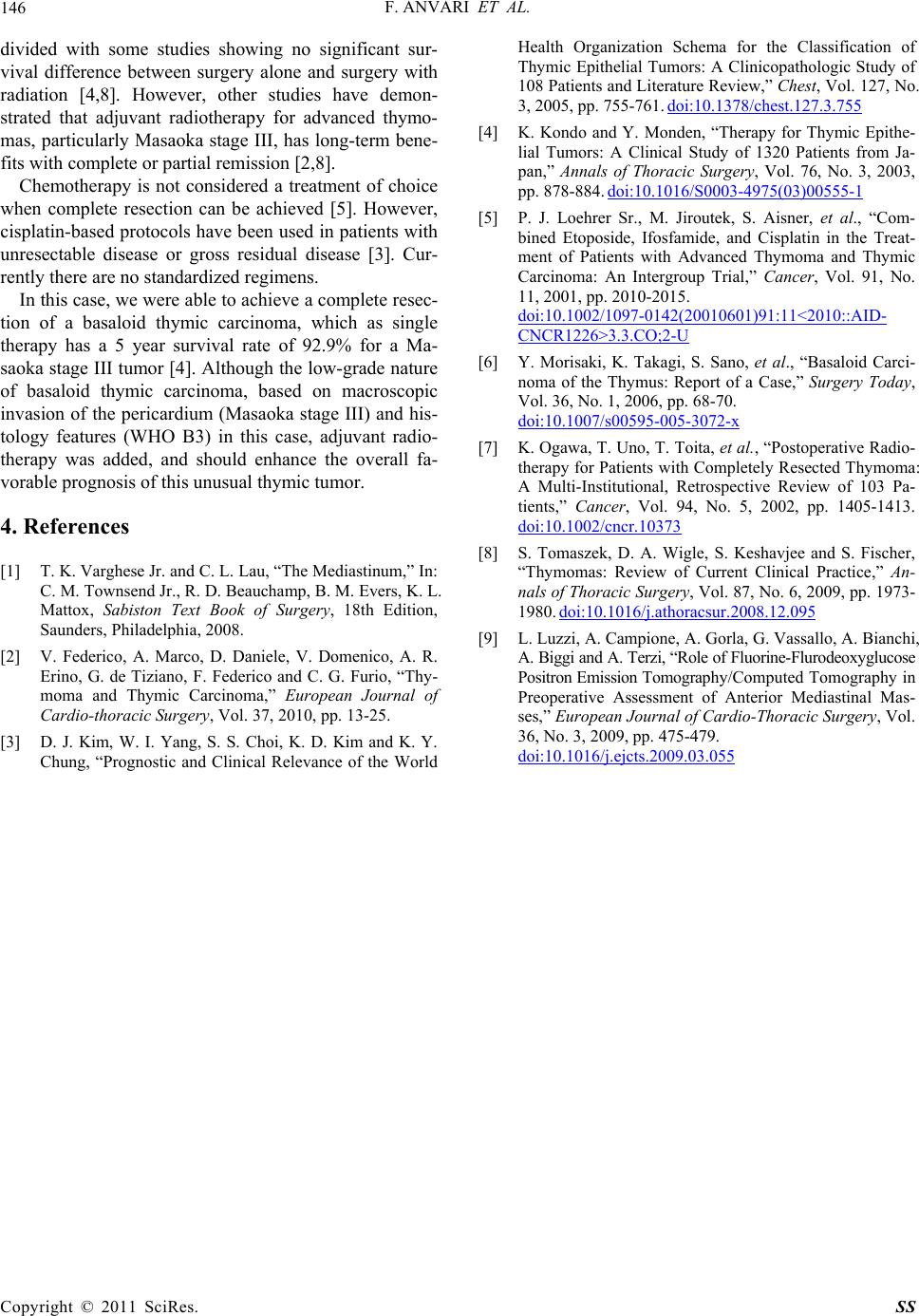
F. ANVARI ET AL.
Copyright © 2011 SciRes. SS
146
divided with some studies showing no significant sur-
vival difference between surgery alone and surgery with
radiation [4,8]. However, other studies have demon-
strated that adjuvant radiotherapy for advanced thymo-
mas, particularly Masaoka stage III, has long-term bene-
fits with complete or partial remission [2,8].
Chemotherapy is not considered a treatment of choice
when complete resection can be achieved [5]. However,
cisplatin-based protocols have been used in patients with
unresectable disease or gross residual disease [3]. Cur-
rently there are no standardized regimens.
In this case, we were able to achieve a complete resec-
tion of a basaloid thymic carcinoma, which as single
therapy has a 5 year survival rate of 92.9% for a Ma-
saoka stage III tumor [4]. Although the low-grade nature
of basaloid thymic carcinoma, based on macroscopic
invasion of the pericardium (Masaoka stage III) and his-
tology features (WHO B3) in this case, adjuvant radio-
therapy was added, and should enhance the overall fa-
vorable prognosis of this unusu a l thymic tumor.
4. References
[1] T. K. Varghese Jr. and C. L. Lau, “The Mediastinum,” In:
C. M. Townsend Jr., R. D. Beauchamp, B. M. Evers, K. L.
Mattox, Sabiston Text Book of Surgery, 18th Edition,
Saunders, Philadelphia, 2008.
[2] V. Federico, A. Marco, D. Daniele, V. Domenico, A. R.
Erino, G. de Tiziano, F. Federico and C. G. Furio, “Thy-
moma and Thymic Carcinoma,” European Journal of
Cardio-thoracic Surgery, Vol. 37, 2010, pp. 13-25.
[3] D. J. Kim, W. I. Yang, S. S. Choi, K. D. Kim and K. Y.
Chung, “Prognostic and Clinical Relevance of the World
Health Organization Schema for the Classification of
Thymic Epithelial Tumors: A Clinicopathologic Study of
108 Patients and Literature Review,” Chest, Vol. 127, No.
3, 2005, pp. 755-761. doi:10.1378/chest.127.3.755
[4] K. Kondo and Y. Monden, “Therapy for Thymic Epithe-
lial Tumors: A Clinical Study of 1320 Patients from Ja-
pan,” Annals of Thoracic Surgery, Vol. 76, No. 3, 2003,
pp. 878-884. doi:10.1016/S0003-4975(03)00555-1
[5] P. J. Loehrer Sr., M. Jiroutek, S. Aisner, et al., “Com-
bined Etoposide, Ifosfamide, and Cisplatin in the Treat-
ment of Patients with Advanced Thymoma and Thymic
Carcinoma: An Intergroup Trial,” Cancer, Vol. 91, No.
11, 2001, pp. 2010-2015.
doi:10.1002/1097-0142(20010601)91:11<2010::AID-
CNCR1226>3.3.CO;2-U
[6] Y. Morisaki, K. Takagi, S. Sano, et al., “Basaloid Carci-
noma of the Thymus: Report of a Case,” Surgery Today,
Vol. 36, No. 1, 2006, pp. 68-70.
doi:10.1007/s00595-005-3072-x
[7] K. Ogawa, T. Uno, T. Toita, et al., “Postoperative Radio-
therapy for Patients with Completely Resected Thymoma:
A Multi-Institutional, Retrospective Review of 103 Pa-
tients,” Cancer, Vol. 94, No. 5, 2002, pp. 1405-1413.
doi:10.1002/cncr.10373
[8] S. Tomaszek, D. A. Wigle, S. Keshavjee and S. Fischer,
“Thymomas: Review of Current Clinical Practice,” An-
nals of Thoracic Surgery, Vol. 87, No. 6, 2009, pp. 1973-
1980. doi:10.1016/j.athoracsur.2008.12.095
[9] L. Luzzi, A. Campione, A. Gorla, G. Vassallo, A. Bianchi,
A. Biggi and A. Terz i, “Role of Flu orine- Flurode oxygluc ose
Positron Emission Tomography/Computed Tomography in
Preoperative Assessment of Anterior Mediastinal Mas-
ses,” European Journal of Cardio-Thoracic Surgery, Vol.
36, No. 3, 2009, pp. 475-479.
doi:10.1016/j.ejcts.2009.03.055